
The Godavari is India's second longest river after the Ganga River and drains the third largest basin in India, covering about 10% of India's total geographical area. Its source is in Trimbakeshwar, Nashik, Maharashtra. It flows east for 1,465 kilometres (910 mi), draining the states of Maharashtra (48.6%), Telangana (18.8%), Andhra Pradesh (4.5%), Chhattisgarh (10.9%) and Odisha (5.7%). The river ultimately empties into the Bay of Bengal through an extensive network of distributaries. Its 312,812 km2 (120,777 sq mi) drainage basin is one of the largest in the Indian subcontinent, with only the Ganga and Indus rivers having a larger drainage basin. In terms of length, catchment area and discharge, the Godavari is the largest in peninsular India, and had been dubbed as the Dakshina Ganga.

Karimnagar is a city and District Headquarters in the Indian state of Telangana. Karimnagar is a major urban agglomeration in the state. It is third largest City in the state and Municipal Corporation and is the headquarters of the Karimnagar district. It is situated on the banks of Manair River, which is a tributary of the Godavari River. It is the third largest and fastest growing urban settlement in the state, according to the 2011 census. It has registered a population growth rate of 45.46% and 38.87% respectively over the past two decades between 1991 and 2011, which is the highest growth rate among major cities of Telangana. It serves as a major educational and health hub for the northern districts of Telangana. It is a major business center and widely known for its agricultural and granite industries, earning the nickname "City of Granites."
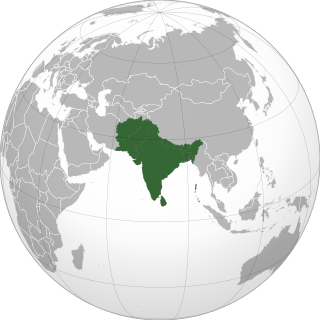
The history of southern India covers a span of over four thousand years during which the region saw the rise and fall of a number of dynasties and empires.

The Satavahanas, also referred to as the Andhras in the Puranas, were an ancient Indian dynasty. Most modern scholars believe that the Satavahana rule began in the late second century BCE and lasted until the early third century CE, although some assign the beginning of their rule to as early as the 3rd century BCE based on the Puranas, but uncorroborated by archaeological evidence. The Satavahana kingdom mainly comprised the present-day Andhra Pradesh, Telangana, and Maharashtra. At different times, their rule extended to parts of modern Gujarat, Madhya Pradesh, and Karnataka. The dynasty had different capital cities at different times, including Kotalingala (Telangana), Pratishthana (Paithan) and Amaravati (Dharanikota).

Nizamabad is a city in the Indian state of Telangana. It is governed by municipal corporation and is the headquarters of the Nizamabad district. Previously part of Hyderabad State and then Andhra Pradesh state, Nizamabad became a part of the newly formed state of Telangana under the Andhra Pradesh Reorganisation Act, 2014. It is located about 186 kilometres (116 mi) north of the state capital, Hyderabad.
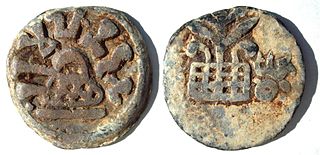
The Chutu dynasty ruled parts of the Deccan region of South India between first and third centuries CE, with its capital at Banavasi in present-day Karnataka state. The Chutus probably rose to power as Satavahanas feudatories, and assumed sovereignty after the decline of the Satavahana power. Except for the edicts of Asoka, the inscriptions of the Chutu dynasty are the oldest documents found in the northern part of Karnataka State, India.
Dhulikatta is a village in Eligaid Mandal in Peddapalli district before it was in Karimnagar District in the state of Telangana earlier known as Andhra Pradesh in India. It is 15 km away from the Peddapalli District centre and 25 km from Karimnagar. The three day Satavahana festival is held there every year in January.

Karimnagar district is one of the 33 districts of the Indian state of Telangana. Karimnagar city is its administrative headquarters. The district shares boundaries with Peddapalli, Jagityal, Sircilla, Siddipet, Jangaon, Hanamkonda district and Jayashankar Bhupalapally districts.

Ramappa Temple, also known as the Rudreshwara temple, is a Kakatiya style Hindu temple dedicated to the Hindu god Shiva, located in Palampet village, Mulugu district, Telangana, India. It is 15 km (9.3 mi) from Mulugu, 66 km (41 mi) from Warangal, 209 km (130 mi) from Hyderabad. An inscription in the temple says it was constructed in the year 1213 CE by Recharla Rudra Reddy—a general of Kakatiya ruler Ganapati Deva. Located in the vicinity of Ramappa Lake, the Ramappa Temple complex which consist of three temples was constructed between 1212 and 1234, designed and architect by Ramappa—after whom the temple complex is named. Marco Polo, during his visit to the Kakatiya empire, supposedly called the temple "the brightest star in the galaxy of temples". In July 2021, Ramappa Temple was declared as a UNESCO World Heritage Site.
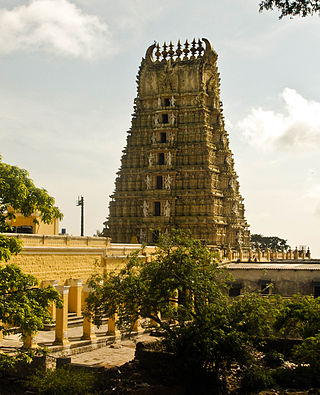
The Chamundeshwari Temple is a Hindu temple located on the top of Chamundi Hills about 13 km from the palace city of Mysuru in the state of Karnataka in India. The temple was named after Chamundeshwari or, the fierce form of Shakti, a tutelary deity held in reverence for centuries by the Maharaja of Mysuru.
Kotilingala is a Hindu pilgrimage site in Jagtial district of the Indian state of Telangana. It is situated in Velagatoor mandal of the district, on the Godavari River. It is located on the bank of the Godavari River, and has a traditional Shiva temple for Hindus, the Koteswara Siddeswara Temple.

The recorded history of Andhra Pradesh, one of the 28 states of 21st-century India, begins in the Vedic period. It is mentioned in Sanskrit epics such as the Aitareya Brahmana. Its sixth-century BCE incarnation Assaka lay between the Godavari and Krishna Rivers, one of sixteen mahajanapadas. The Satavahanas succeeded them, built Amaravati, and reached a zenith under Gautamiputra Satakarni.
The Andh are a designated Scheduled Tribe in the Indian states of Maharashtra, Telangana and Andhra Pradesh. Andhs have the originated from the Satavahan dynasty.Andh community is one of the oldest Tribals community in India At the time of Satvahan rule, the king was the owner of the lands and the forests but some time after the death of the Satvahan king, the East India Company decreed all lands and forests under their governance. This was the cause of the Andh becoming isolated and non-progressed. They seem to have is originated in southern India in the vicinity of Madras which was once ruled by the Andhra dynasty. However the identification is only used for the people who by the start of the 20th century had a long history of presence in central India.
Metpally is a town and Revenue Division and third largest town in Jagtial district of the Indian state of Telangana. It is located 222 km from the state capital Hyderabad, 67 km from Nizamabad, 80 km from Karimnagar and 33 km from district headquarters Jagtial. Many dynasties ruled including Sathavahanas and Kakatiyas. The Kakatiyas built a temple named Chennakesava.

Kothapally is a village in the Mupkal Mandal in the Nizamabad (Indhooru) district in the State of Telangana in India.
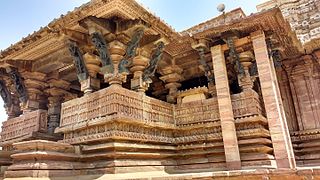
The earliest temples in Telangana include the Alampur Navabrahma Temples built during the 6th century CE by the Badami Chaulukyas.

The history of Telangana, located on the high Deccan Plateau, includes its being ruled by the Satavahana Dynasty, the Kakatiya Dynasty (1083–1323), the Musunuri Nayaks (1325–1438), the Delhi Sultanate, the Bahmani Sultanate (1347–1512), Golconda Sultanate (1512–1687) and Asaf Jahi dynasty (1724–1950).

The Culture of Telangana in India has a cultural history of about 5,000 years. The region emerged as the foremost centre of culture in Indian subcontinent during the rule of Kakatiyas, the Qutb Shahis and Asaf Jahi dynasties—. The rulers patronage and interest for culinary, arts and culture transformed Telangana into a multi-cultural region where two different cultures coexist together, thus making Telangana the representative of the Deccan Plateau and its heritage with Warangal and Hyderabad being its epicenter. Hyderabadi cuisine and Kakatiya architecture both from Telangana, are on the list of UNESCO creative city of gastronomy and UNESCO World Heritage Site. The regions major cultural events celebrated are "Kakatiya Festival" and Deccan Festival along with religious festivals Bonalu, Bathukamma, Dasara, Ugadi, Sankranthi, Milad un Nabi and Ramadan.
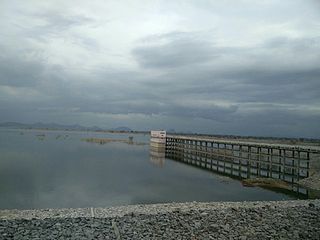
Mancherial district is a district located in the northern region of the Indian state of Telangana. The district comprises 18 mandals and two revenue divisions – Mancherial and Bellampalli. The district headquarters is located at Mancherial town. It is surrounded by Komaram Bheem, Nirmal, Jagtial, Peddapalli and Bhupalpally districts of Telangana and with Maharashtra state.

Bommalagutta is a Jain centre situated near Kurikyala village of Karimnagar district in Telangana. This Jain center is situated 3 km from another famous Jain center Kulpakji.
















